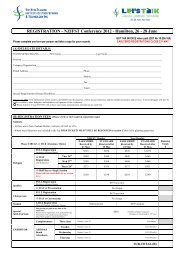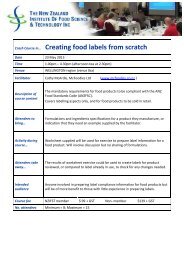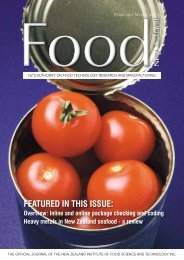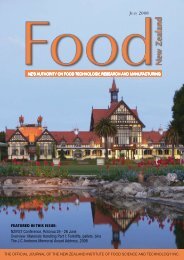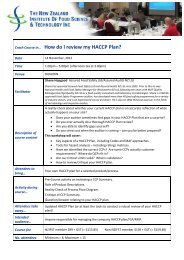featured in this issue - NZIFST - The New Zealand Institute of Food ...
featured in this issue - NZIFST - The New Zealand Institute of Food ...
featured in this issue - NZIFST - The New Zealand Institute of Food ...
Create successful ePaper yourself
Turn your PDF publications into a flip-book with our unique Google optimized e-Paper software.
Protect<strong>in</strong>g IP <strong>in</strong> novel food <strong>in</strong>gredients<br />
and derived products<br />
Dr Shayne Nam, Technical Adviser, James & Wells Intellectual Property<br />
LEGAL MATTERS<br />
<strong>Food</strong> <strong>in</strong>gredients are the life blood <strong>of</strong> the food <strong>in</strong>dustry, and many commercial<br />
products conta<strong>in</strong> “secret <strong>in</strong>gredient(s)” which their manufacturer<br />
claims give them a competitive advantage over rivals.<br />
In today’s market <strong>of</strong> fast mov<strong>in</strong>g consumer goods, the push to develop<br />
or discover improved <strong>in</strong>gredients that act as substitutes for natural<br />
agents while provid<strong>in</strong>g benefits such as <strong>in</strong>creased nutrition and shelf<br />
life has never been stronger. For that reason alone, food <strong>in</strong>gredient<br />
manufacturers devote a large amount <strong>of</strong> resources to cont<strong>in</strong>ued R&D<br />
to discover that vital <strong>in</strong>gredient.<br />
Once they have developed a novel food <strong>in</strong>gredient(s) or food product<br />
conta<strong>in</strong><strong>in</strong>g them, and want to ma<strong>in</strong>ta<strong>in</strong> the advantage over competitors,<br />
there are some options available.<br />
Keep as a trade secret?<br />
Trade secrets are commonly used <strong>in</strong> the food <strong>in</strong>dustry to protect <strong>in</strong>gredients,<br />
compositions, formulas, and methods <strong>of</strong> manufacture or<br />
processes. <strong>The</strong> use <strong>of</strong> trade secrets may be applicable where the product/process<br />
does not meet certa<strong>in</strong> patentability criteria. An essential requirement<br />
<strong>of</strong> trade secret protection is that total secrecy is ma<strong>in</strong>ta<strong>in</strong>ed.<br />
This requires that people <strong>in</strong>side the organisation do not divulge sensitive<br />
<strong>in</strong>formation to anyone external.<br />
In some circumstances, trade secrets can provide advantages over other<br />
types <strong>of</strong> <strong>in</strong>tellectual property (IP) protection such as patents. <strong>The</strong>se<br />
<strong>in</strong>clude no registration costs, and protection will rema<strong>in</strong> <strong>in</strong>def<strong>in</strong>itely<br />
subject to the <strong>in</strong>formation rema<strong>in</strong><strong>in</strong>g a secret (compared to 20 years<br />
for a patent).<br />
However, there are several disadvantages associated with the use <strong>of</strong><br />
trade secrets. For example, vigilance must be constantly ma<strong>in</strong>ta<strong>in</strong>ed<br />
to ensure confidentiality <strong>of</strong> the secret. In practical terms <strong>this</strong> can be<br />
difficult depend<strong>in</strong>g on factors such as the nature <strong>of</strong> the secret, and the<br />
loyalty and trustworthy nature <strong>of</strong> employees.<br />
Coca-Cola is <strong>of</strong>ten touted as an example <strong>of</strong> a successful trade secret <strong>in</strong><br />
action. However, with recent advances <strong>in</strong> analytical techniques, and<br />
the emergence <strong>of</strong> Pepsi-Cola, whether it still is, or will rema<strong>in</strong> a trade<br />
secret is open to debate.<br />
Other food <strong>in</strong>gredients and products conta<strong>in</strong><strong>in</strong>g them may be readily<br />
assessed and the ‘secret <strong>in</strong>gredient’ obta<strong>in</strong>ed via ‘reverse eng<strong>in</strong>eer<strong>in</strong>g’.<br />
In fact, some companies specialise <strong>in</strong> reverse eng<strong>in</strong>eer<strong>in</strong>g food <strong>in</strong>gredients<br />
and related products. Once the secret has been discovered, any<br />
third party is entitled to use it – only patents provide exclusive rights to<br />
exclude third parties from mak<strong>in</strong>g commercial use <strong>of</strong> it.<br />
has developed a new food product which conta<strong>in</strong>s a vital proprietary<br />
food <strong>in</strong>gredient, one way for them to ma<strong>in</strong>ta<strong>in</strong> their competitive advantage<br />
is to have an exclusive agreement with their <strong>in</strong>gredient supplier<br />
to prevent their competitor obta<strong>in</strong><strong>in</strong>g the same vital <strong>in</strong>gredient and/or<br />
composition.<br />
However, a disadvantage <strong>of</strong> rely<strong>in</strong>g on an exclusive agreement is that<br />
it does not prevent a competitor from obta<strong>in</strong><strong>in</strong>g <strong>in</strong>formation on a new<br />
food product via “reverse eng<strong>in</strong>eer<strong>in</strong>g” and then produc<strong>in</strong>g the same<br />
product us<strong>in</strong>g generic <strong>in</strong>gredients.<br />
In addition, what happens if the <strong>in</strong>gredient manufacturer goes out <strong>of</strong><br />
bus<strong>in</strong>ess or is no longer able to supply the <strong>in</strong>gredient?<br />
Patents – a viable protection<br />
option<br />
One <strong>of</strong> the most applicable forms <strong>of</strong> IP protection for novel food <strong>in</strong>gredients<br />
and derived products is patents. Patents for novel food <strong>in</strong>gredients<br />
can be wide <strong>in</strong> scope and cover many variations <strong>of</strong> a basic<br />
product or process.<br />
Some successful examples <strong>in</strong>clude the patent<strong>in</strong>g <strong>of</strong> the flavour enhancer<br />
monosodium glutamate (MSG) <strong>in</strong> 1908, and the artificial sweetener<br />
sucralose <strong>in</strong> 1976 by Tate & Lyle. More recently, Senomyx (a company<br />
which develops novel flavour <strong>in</strong>gredients and is the owner or exclusive<br />
licensee <strong>of</strong> several hundred patents) has recently been granted a patent<br />
for S2383, a unique flavour <strong>in</strong>gredient which allows the quantity <strong>of</strong> sucralose<br />
<strong>in</strong> food products to be reduced by up to 75% while ma<strong>in</strong>ta<strong>in</strong><strong>in</strong>g<br />
the desired sweet taste.<br />
It is also possible to protect a comb<strong>in</strong>ation <strong>of</strong> two or more known<br />
<strong>in</strong>gredients if it can be shown that synergy exists between these <strong>in</strong>gredients,<br />
or there is an unexpected effect by comb<strong>in</strong><strong>in</strong>g them. Depend<strong>in</strong>g<br />
on the degree <strong>of</strong> <strong>in</strong>ventiveness, it may also be possible to protect<br />
related products which provide similar benefits. Tip Top, one <strong>of</strong> <strong>New</strong><br />
<strong>Zealand</strong>’s lead<strong>in</strong>g ice cream companies, owns a number <strong>of</strong> patents.<br />
An example <strong>in</strong>cludes a patent for its Memphis Meltdown ® ice cream<br />
which comb<strong>in</strong>es known <strong>in</strong>gredients <strong>in</strong> a unique arrangement (triple<br />
layer dipp<strong>in</strong>g us<strong>in</strong>g caramel and chocolate).<br />
Patent<strong>in</strong>g food <strong>in</strong>gredients and derived products provides a wealth <strong>of</strong><br />
bus<strong>in</strong>ess opportunities as the scope for on-licens<strong>in</strong>g that patent could<br />
be considerable. <strong>The</strong> specific advice <strong>of</strong> patent specialists will ensure<br />
that companies can capitalise on the IP <strong>of</strong> their novel food <strong>in</strong>gredients<br />
and derived products. This means they can ma<strong>in</strong>ta<strong>in</strong> their competitive<br />
advantage and market edge.<br />
Exclusive agreement with food<br />
<strong>in</strong>gredient supplier<br />
Most FA 15563 food JAWS manufacturers <strong>Food</strong> Mag Ad source pth.pdf raw 1 food 21/09/11 <strong>in</strong>gredients 4:48 from PM specialist<br />
<strong>in</strong>gredient manufacturers and suppliers. If the food manufacturer<br />
Shayne Nam is part <strong>of</strong> James & Wells Intellectual Property’s Chemical<br />
and Process Technology Patents Team. He specialises <strong>in</strong> patents relat<strong>in</strong>g<br />
to formulations and compositions. If you have any queries regard<strong>in</strong>g IP<br />
protection, Shayne can be contacted by email on: shaynen@jaws.co.nz<br />
October/November 2011 33



